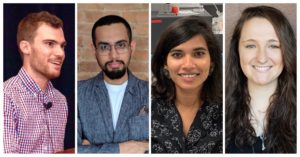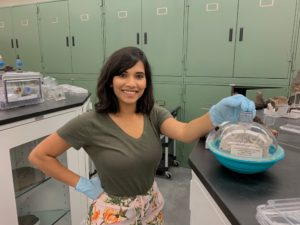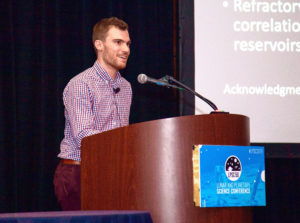Nininger Student Travel Award recipients
 The Center for Meteorite Studies and the School of Earth and Space Exploration (SESE) are pleased to announce the winners of the 2020 Nininger Student Travel Award. The goal of this award is to support travel to the annual Lunar and Planetary Science Conference (LPSC) of up to 4 SESE undergraduate and/or graduate students to present their latest research. Note that LPSC was cancelled this year, due to Covid-19.
The Center for Meteorite Studies and the School of Earth and Space Exploration (SESE) are pleased to announce the winners of the 2020 Nininger Student Travel Award. The goal of this award is to support travel to the annual Lunar and Planetary Science Conference (LPSC) of up to 4 SESE undergraduate and/or graduate students to present their latest research. Note that LPSC was cancelled this year, due to Covid-19.
The awardees are:
Madeline Marquardt
 Madeline is a 4th year undergraduate student studying Astrobiology. Her research with Professors Thomas Sharp and Mélanie Barboni focuses on impacted meteorites from the asteroid Vesta. Having characterized the petrography and impact history of her sample (NWA 8677), she now focuses on zircon grains present. Using zircon as an extremely old and reliable clock, she can analyze all of the zircon of sufficient size in her sample to obtain high-spatial resolution U-Pb ages by Secondary Ion Mass Spectrometry (SIMS). These ages will put timestamps on when impact events were occurring on Vesta and the crystallization age of zircon. Further analyses of element substitution (Ti, Al, Mg, Fe) in zircon by SIMS will aid in determining the initial bulk composition of the magma ocean and apparent crystallization temperature of zircon. The brilliant potential of zircon in meteorites will help to better understand the impact and geologic history of early-formed bodies in our Solar System.
Madeline is a 4th year undergraduate student studying Astrobiology. Her research with Professors Thomas Sharp and Mélanie Barboni focuses on impacted meteorites from the asteroid Vesta. Having characterized the petrography and impact history of her sample (NWA 8677), she now focuses on zircon grains present. Using zircon as an extremely old and reliable clock, she can analyze all of the zircon of sufficient size in her sample to obtain high-spatial resolution U-Pb ages by Secondary Ion Mass Spectrometry (SIMS). These ages will put timestamps on when impact events were occurring on Vesta and the crystallization age of zircon. Further analyses of element substitution (Ti, Al, Mg, Fe) in zircon by SIMS will aid in determining the initial bulk composition of the magma ocean and apparent crystallization temperature of zircon. The brilliant potential of zircon in meteorites will help to better understand the impact and geologic history of early-formed bodies in our Solar System.
Soumya Ray
 Soumya is a PhD candidate in the School of Earth and Space Exploration working with Professor Meenakshi Wadhwa. Her research focuses on measuring the stable isotope composition of meteorites in the Isotope Cosmochemistry and Geochronology Laboratory at ASU. Specifically, she studies the Fe and Si isotope composition of a variety of bulk achondrites as well as mineral separates from these achondrites. At LPSC, she will present a new method for the purification of Fe and Si from the same aliquots of digested and dissolved samples. A coupled investigation of both Fe and Si isotopes in bulk meteorites and mineral separates could provide important constraints on processes occurring during accretion and differentiation of meteorite parent bodies and help answer whether Fe and Si isotopes fractionate during core formation.
Soumya is a PhD candidate in the School of Earth and Space Exploration working with Professor Meenakshi Wadhwa. Her research focuses on measuring the stable isotope composition of meteorites in the Isotope Cosmochemistry and Geochronology Laboratory at ASU. Specifically, she studies the Fe and Si isotope composition of a variety of bulk achondrites as well as mineral separates from these achondrites. At LPSC, she will present a new method for the purification of Fe and Si from the same aliquots of digested and dissolved samples. A coupled investigation of both Fe and Si isotopes in bulk meteorites and mineral separates could provide important constraints on processes occurring during accretion and differentiation of meteorite parent bodies and help answer whether Fe and Si isotopes fractionate during core formation.
Vishaal Singh
 Vishaal is a PhD candidate in Geological Sciences at ASU’s School of Earth and Space Exploration, working with Professor Steve Desch and Dr. Alyssa Rhoden on Ocean World exploration. Using a three-pronged (or ‘Trident’) approach, Vishaal is developing techniques to probe the thermomechanical and compositional properties of dynamic ice shells, viewed as a remote sensing target, a site for in situ exploration, and through the depth of the shell. He combines investigations on Jupiter’s moon Europa, using remote sensing data (photometry), lab studies & modeling (ice spectroscopy and mechanics), and instrumentation development, to identify the limits of our diagnostic capabilities and new pathways for exploration. In this abstract, Vishaal and his co-authors explore the interrelationship between grain size, chemical composition, radiation processing, and thermal cycling of ice samples (and their spectra) in the lab, and test how they alter our current understanding of Europa’s surface – this is necessary to identify the likely locations of recent activity where we may find biosignatures. They find that the collected lab spectra change due to these listed parameters, but also differ from previous modeling efforts, particularly for the 1.65 μm water-ice band which is used to assess the crystallinity of the surface. This has significant implications for our understanding of how Europa’s surface ice evolves with temperature and radiation.
Vishaal is a PhD candidate in Geological Sciences at ASU’s School of Earth and Space Exploration, working with Professor Steve Desch and Dr. Alyssa Rhoden on Ocean World exploration. Using a three-pronged (or ‘Trident’) approach, Vishaal is developing techniques to probe the thermomechanical and compositional properties of dynamic ice shells, viewed as a remote sensing target, a site for in situ exploration, and through the depth of the shell. He combines investigations on Jupiter’s moon Europa, using remote sensing data (photometry), lab studies & modeling (ice spectroscopy and mechanics), and instrumentation development, to identify the limits of our diagnostic capabilities and new pathways for exploration. In this abstract, Vishaal and his co-authors explore the interrelationship between grain size, chemical composition, radiation processing, and thermal cycling of ice samples (and their spectra) in the lab, and test how they alter our current understanding of Europa’s surface – this is necessary to identify the likely locations of recent activity where we may find biosignatures. They find that the collected lab spectra change due to these listed parameters, but also differ from previous modeling efforts, particularly for the 1.65 μm water-ice band which is used to assess the crystallinity of the surface. This has significant implications for our understanding of how Europa’s surface ice evolves with temperature and radiation.
Zack Torrano
 Zack is a PhD candidate in the School of Earth and Space Exploration advised by Professor Meenakshi Wadhwa. At LPSC, he will be presenting his work on the combined Cr, Ti, and O isotopic systematics of meteorites that was conducted in the Isotope Cosmochemistry and Geochronology Laboratory at ASU. These combined isotope systems are used to trace genetic relationships between meteorites, and the goal of this work is to measure the isotopic compositions of ungrouped chondrites for the purpose of evaluating the relationship between CM and CO chondrites. Studies of CM (and CM-like ungrouped) chondrites are particularly important as these meteorites may be analogs for the carbonaceous asteroids targeted by the ongoing OSIRIS-REx and Hayabusa2 sample return missions.
Zack is a PhD candidate in the School of Earth and Space Exploration advised by Professor Meenakshi Wadhwa. At LPSC, he will be presenting his work on the combined Cr, Ti, and O isotopic systematics of meteorites that was conducted in the Isotope Cosmochemistry and Geochronology Laboratory at ASU. These combined isotope systems are used to trace genetic relationships between meteorites, and the goal of this work is to measure the isotopic compositions of ungrouped chondrites for the purpose of evaluating the relationship between CM and CO chondrites. Studies of CM (and CM-like ungrouped) chondrites are particularly important as these meteorites may be analogs for the carbonaceous asteroids targeted by the ongoing OSIRIS-REx and Hayabusa2 sample return missions.